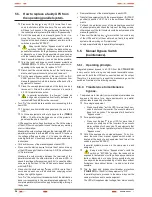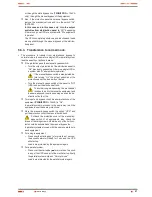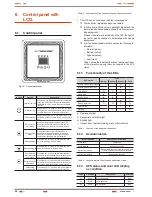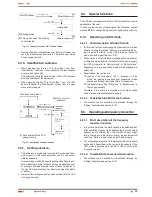
20
Accumulator cabinet or modules have battery protection
too, and in this case, they are duplicated. An internal ones
through fuses with no access for the end-user and an addi-
tional ones by means of a two pole circuit breaker.
•
IMPORTANT FOR SAFETY: In case of installing the
batteries by yourself, the accumulators has to be pro-
vided with a two pole circuit breaker protection sized to the
features stated in table 2.
•
Before starting the connection between the bat-
tery module/s and the equipment, check that the
equipment switch/es and the one in the battery cabinet
are in "Off" position.
•
Connection terminals with the external batteries are in the
same power block of the equipment, less in
TWIN/3 PRO
up
to 10 kVA, which have an Anderson connector.
•
Connection of the UPS with the battery cabinet will be done by
means of a supplied bundle cables, connecting, at first stage,
one of the ends to the power block or Anderson connector of
the UPS and then the other end to the power block or Anderson
connector of the battery cabinet, by respecting the polarity
stated in the labelling of the equipment and this manual, and
colour of the cables (red for positive, black for negative, green-
yellow for earth).
Battery modules with Anderson connector there is no pos-
sibility to make a mistake in the polarity.
Table 3 states the battery connection type, which are avail-
able in the UPS and battery modules.
Model
Battery connection terminals
In the UPS
In the external
battery module
SLC-4000-TWIN PRO
Power block
Anderson connector
SLC-5000-TWIN PRO
SLC-6000-TWIN PRO
SLC-8000-TWIN PRO
Power block
SLC-10000-TWIN PRO
SLC-8000-TWIN/3 PRO
Anderson connector Anderson connector
SLC-10000-TWIN/3 PRO
SLC-12000-TWIN/3 PRO
Power block
Power block
SLC-15000-TWIN/3 PRO
SLC-20000-TWIN/3 PRO
Table 3.
Type of connection terminals in the UPS and battery
module.
•
When it is supplied more than one battery unit for each
equipment, the connection will always be done in parallel
between them and the equipment. So it means, black cable
from negative of the UPS to the first negative of the first bat-
tery module and from this last negative to the second module
and so on. Proceed in the same way to connect the red posi-
tive cable and the green-yellow earth cable.
•
In parallel systems, the connection of each equipment with
its external battery cabinet/s has to be done like if they were
single units, completely separate from the rest ones.
•
Each battery module is independent for each equip-
ment.
It is strictly prohibited to connect two
equipments to one battery module
.
4.3.5. Connection of main input earth
terminal
(
)
and the earth bonding
terminal
(
)
.
•
As this is a device with class I protection against elec-
tric shocks, it is essential to install a protective earth
conductor (connect earth
(
)
). Connect the conductor to
the terminal or bar, before connecting the power supply to the
UPS input.
•
Make sure that all the loads connected to the UPS are only
connected to the protective earth bonding terminal (
). The
fact of not restricting the earthing of the load or loads and/
or the batteries case/s or cabinet/s to this
single point
will
create a return loops to earth which will affect the quality of
the supplied power .
•
All terminals identified as earth bonding
(
)
, are joined
together, to the main protective earthing terminal
(
)
and
to the frame of the device.
4.3.6. Terminals for EPO (Emergency Power Off).
•
All UPSs have a terminal strip to install an external button, for
Emergency Power Off (EPO).
•
The equipment is preset from factory with the EPO as nor-
mally open contact. So, the UPS will break the output power
supply when the circuit is open:
Either by removing the female connector inserted in the
plinth. This connector has a cable bridge to close the circuit
(Fig. A).
Fig. A
Fig. B
Or by turning on the external button installed and be-
longing to the end-user. The connection in the button has
to be in normally closed because it will open the circuit
when turning it on.
•
Through the control panel, it can be selected the reverse
functionality, normally closed.
Less punctual cases, it is not recommended to use this type
of connection due to the function of the EPO button, because
it would not work in case of any of the two cables that goes
from the button to the UPS were cut (damaged).
On the other hand this failure would be immediately detected
in the normally open EPO type, with the inconvenience of
the sudden break in the power supply to the loads, but with
a complete guarantee of the functioning of the emergency
power off.
•
To restore the normal operating mode of the UPS, the con-
nector with the cable bridge has to be fitted back in the ter-
minal strip or to deactivate the EPO button and later on to
cancel the EPO status in the control panel . The equipment
will be operative.
USER MANUAL
Summary of Contents for SLC TWIN PRO Series
Page 2: ......
Page 43: ...43 SALICRU...
















































